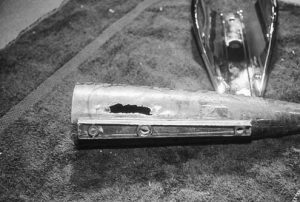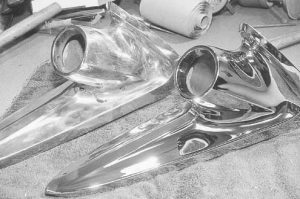Understanding Restoration
Important Information. Please Read This.
Pot metal is a very unstable, unpredictable, and difficult metal to deal with and restore. During the casting process, air bubbles are formed throughout the entire piece. That is in part why pot metal is almost always pitted. The process I use to repair pot metal is to drill out the pits, fill them with silver solder and triple plate (copper, nickel, and chrome).
Not all pot metal can be restored to show quality. If there are pits between ribs or pits in corners where vertical and horizontal planes meet or any other place on the piece that is not accessible, there will be some imperfections. I usually do not repair pits on surfaces that are painted or covered by other trim or wood graining. These areas can be filled in with an epoxy, body filler, or a high build primer prior to painting. If there are cracks, holes, or broken areas, these add to the complexity and cost of the repair. The normal turn around time is about six weeks, but this time frame can easily double or triple for the following reasons.
In order for chrome plating to “stick” on pot metal, the entire piece must be pristine with no oxidation, corrosion, or imperfections AT ALL. Some times, the piece can look clean to the naked eye and may even take to plating, but within a day or two a bubble or bubbles can form under the plating. If this happens it will do so in a short period of time. Because pot metal is full of holes like a sponge, the clean surface can be on the verge of opening up a pit just beneath. As soon as the plating chemicals hit the surface, it can open it up causing a bubble to appear. In such cases, the piece must be completely stripped of all plating and the process started again.
Often, the true extent of the damage does not reveal itself until the chrome is stripped off. Much like the rust under paint, you don’t know the real story until you get down to the base metal. On large areas of repair, the heat necessary to flow the silver solder can and usually does open up additional pits. Heat expands trapped air bubbles and you can sometimes hear these bursting. Because of the nature of this metal, it is sometimes necessary to do the repair more than once and occasionally several times to achieve the desired results. This will extend the time and the cost it takes to finish the piece. I always try to stay within the estimated price quote even if I have to redo the repair, but occasionally there can be additional costs added to the quote. In that event, I will let you know what the problem is and try to estimate the additional time and costs involved. 80% of the pot metal that I do is completed on time and within the cost estimate, the remainder is not.
 Almost all pot metal has pits. During the casting process, air bubbles get trapped as the metal is poured into the mold. This is why it is possible to have an NOS (new old stock) piece that has never been on a car and yet it is pitted. Pits can range in size from a pin point to an entire section of the piece. It is nearly impossible to tell how badly pitted a piece is until the chrome is stripped off. If the piece looks like a cheese pizza, chances are the trim underneath is going to be very corroded.
Almost all pot metal has pits. During the casting process, air bubbles get trapped as the metal is poured into the mold. This is why it is possible to have an NOS (new old stock) piece that has never been on a car and yet it is pitted. Pits can range in size from a pin point to an entire section of the piece. It is nearly impossible to tell how badly pitted a piece is until the chrome is stripped off. If the piece looks like a cheese pizza, chances are the trim underneath is going to be very corroded.

 There are a great number of variables to consider, and a lot of things that can go wrong with pot metal restoration. Perfection has its cost. Not all pot metal can be restored and results depend on the integrity of the piece, not just the surface appearance. That said, there is no question that the better the piece is on visual inspection, the better the results you can expect. Be advised that while there are plating businesses to choose from in any given area, many will not properly handle your assorted car parts. While they may accept your trim for plating, they are not geared towards detail work. Your valuable and rare parts will receive no more attention than the 100,000 door knobs they are processing that week. This does not lend itself to pleasing results.
There are a great number of variables to consider, and a lot of things that can go wrong with pot metal restoration. Perfection has its cost. Not all pot metal can be restored and results depend on the integrity of the piece, not just the surface appearance. That said, there is no question that the better the piece is on visual inspection, the better the results you can expect. Be advised that while there are plating businesses to choose from in any given area, many will not properly handle your assorted car parts. While they may accept your trim for plating, they are not geared towards detail work. Your valuable and rare parts will receive no more attention than the 100,000 door knobs they are processing that week. This does not lend itself to pleasing results.